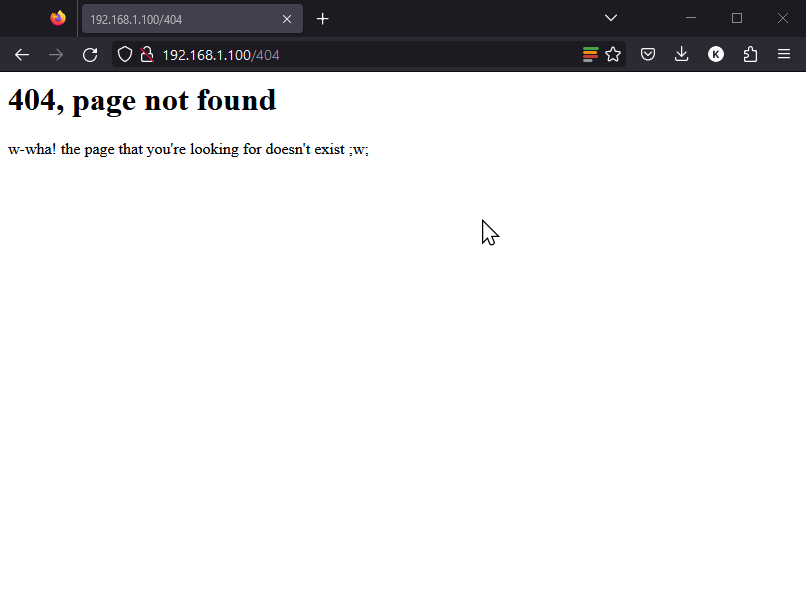Creating randomly-selected 404 pages
Table of Contents
One of the artists I listen to, Emma Essex, has this cool thing on their website where the 404 page is a different one every time. I thought to myself that this can be done simply and it surprisingly can be done pretty easily.
All it requires is a cgi-bin script, a folder full of HTML files, and some extra stuff in nginx.
Initializing
I’ll be using /var/www/html as the root folder for all my stuff, and I’ll be using nginx on Rocky Linux 9.x.
First off, create 2 directories in your /var/www/html folder;
cgi-bin- Folder where our script will go
404_pages- Directory where pages will be randomly selected.
I’ve made 2 files in the 404_pages directory.
simple.html
<h1>404, page not found.</h1>
<p>The page that you're looking for doesn't exist.</p>
and simple_alt.html
<h1>404, page not found</h1>
<p>w-wha! the page that you're looking for doesn't exist ;w;</p>
I’ve also made a script in the cgi-bin directory with the name of rand.sh.
#!/bin/bash
item=$(find /var/www/html/404_pages -type f | shuf -n 1)
echo "Content-Type: text/html"
echo ""
cat $item
Make sure that the rand.sh file has the correct permissions
sudo chown nginx:nginx /var/www/html/cgi-bin/rand.sh
sudo chmod 777 /var/www/html/cgi-bin/rand.sh
You also need to install the fcgiwrap package.
# debian-based
sudo apt install fcgiwrap
# rhel-based
sudo dnf install fcgiwrap
Adding stuff in the nginx config
For the fcgi stuff to work, you need to add a couple of things to your nginx config.
Here’s a basic config that creates a new route at /404 which then runs the fgci script result, and it will replace the 404 route with the output contents of the fcgi script.
server {
listen 80;
server_name _;
root /var/www/html/;
index index.html;
error_page 404 /404;
location = /404 {
gzip off;
include fastcgi_params;
fastcgi_pass unix:/var/run/fcgiwrap.sock;
fastcgi_param SCRIPT_FILENAME /var/www/html/cgi-bin/rand.sh;
}
}
Extra scripts to make things work properly
With the way that fcgiwrap is configured, there are a couple of things you need to do in order to get it working.
Create the file /etc/systemd/system/fcgiwrap.service with the following content
[Unit]
Description=FastCGIWrap Service
After=network-online.target
[Service]
Type=exec
ExecStart=/usr/sbin/fcgiwrap
User=nginx
Group=nginx
[Install]
WantedBy=multi-user.target
Also create the file /etc/systemd/system/fcgiwrap.socket with the following content
[Unit]
Description=FastCGIWrap Socket
[Socket]
ListenStream=/run/fcgiwrap.sock
User=nginx
Group=nginx
[Install]
WantedBy=sockets.target
You also need to create a service which sets the correct permissions for the /run/fcgiwrap.sock file
Create the script at /root/fcgi-init.sh and make sure it’s chmod is 777
#!/bin/bash
chown nginx:nginx -R /var/run/fcgiwrap.sock
chmod 777 /var/run/fcgiwrap.sock
And create the service at the location /etc/systemd/system/fcgi-init.service
[Unit]
Description=Initialize FCGIWrap Service
After=network-online.target
[Service]
Type=exec
ExecStart=/root/fcgi-init.sh
User=root
Group=root
[Install]
WantedBy=multi-user.target
Finalizing
Make sure that all the services are running and enabled
systemctl enable --now fcgiwrap.socket
systemctl enable --now fcgiwrap.service
systemctl enable --now fcgi-init.service
Now when you try and load a page that doesn’t exist, it should use one of the files in /var/www/html/404_pages.

